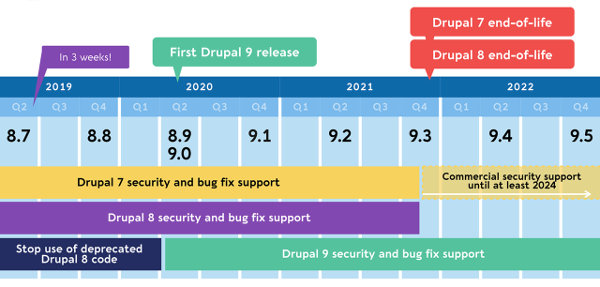
We’re excited to hear your project.
Let’s collaborate!

These days, this is the question on the lips and minds of anyone developing/designing/creating content in Drupal or (just) managing a Drupal website: "What's new in Drupal 9?".
The "fear" is there and it's legitimate...
For the (bad) experience that you've had with upgrading from Drupal 7 to Drupal 8 is still haunting you, isn't it? You just cannot forget that the whole process quickly turned into a rewriting of Drupal from the ground up...
Your contributed modules were not compatible with Drupal 8 and there was a ton of custom code to be rewritten...
So, how would an honest "Drupal 9 vs Drupal 8" comparison look like? What completely revolutionary and therefore high-impact features should you expect and... plan for (at least psychologically)?
And I bet that you don't settle for the "The great news is that... there's no breaking news at all" type of answer, either. That's why we've gone beyond this explanation that everyone seems to have embraced by default and dug deeper.
The result? An inventory of all the changes (for there will be, even if not as dramatic as those that we've got used to from the previous major Drupal releases), ranging from:
So, let's dive right in, shall we?
And this is the most exciting "no big news, yet a significant mind-shift" type of answer to your "What's new in Drupal 9?" question.
It looks like the Drupal community has learned from its past mistakes... the hard way and it's determined to prevent them. What does this mean for you?
It means that beginning with Drupal 9 all major Drupal software releases will be seamless, painless and... buttery smooth. Basically, Drupal 9 is Drupal 8 stripped off all its deprecated code.
If you've removed all old code and dependencies by Drupal 8.9, upgrading your website to Drupal 9 will be as hassle-free as... any Drupal release.

Image source: Drupal.org
Ready to say goodbye to Symfony 3? It will get replaced with Symfony 4 or 5 after November 2021.
Also, expect an upgrade to Twig 2.0.
These upgrades can only translate into higher performance, improved developer experience, and enhanced security.
Tip: you might want to take Symfony 4 for a short test drive on your Drupal 8 website, just to see how well it handles the new version.
Another valid answer to your "What's new in Drupal 9?" question is:
It won't support any code marked as deprecate in Drupal 8.
Tip: since this "sanitizing" process is going to be a long, ongoing one, we suggest you turn it into a routine; keep removing out of date code from your Drupal 8 website to make sure that upgrading it to Drupal 9 will be as... buttery smooth as possible.
Image by Michael Schwarzenberger from Pixabay
Now, this is definitely a standout change, that breaks away from the "the news is that... there is no news" opinion.
Practically, there are high chances that contributed modules share a single codebase so that they can work both on Drupal 9 and Drupal 8 websites.
And that's...new in Drupal. A whole new paradigm.
With all deprecated functionality getting removed by the time Drupal 9 gets released, its load of dependencies will get significantly lighter.
"What's new in Drupal 9?" Well, most likely Panelizer will get replaced with the Layout Builder, the "rockstar" module of the moment.
So, you'd better consider letting go of this module.

Image by Gerd Altmann from Pixabay
Call it a change, a new approach or... just "something" that sets Drupal 9 apart from its predecessor:
By the time it'll get released, all Drupal 8 contributed modules will be fully compatible with this new major version of Drupal. Almost half of the Drupal 8 modules turned out to be compatible with the analysis run in April this year, so... the future looks highly promising.
The "nothing new in Drupal 9" shared opinion isn't 100% accurate.
Ok, if we compared this upgrade to the previous one, all these mind-shifts and new approaches in Drupal 9 are, indeed, no painfully disruptive changes.
No new dramatic paradigms of development. But they are, nevertheless... changes.
Differences...
Not so much between Drupal x and Drupal 9, but between an old and a new model of upgrading Drupal.
Main photo by Jon Tyson on Unsplash

We’re excited to hear your project.
Let’s collaborate!